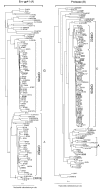Recombinant viruses initiated the early HIV-1 epidemic in Burkina Faso
- PMID: 24647246
- PMCID: PMC3960253
- DOI: 10.1371/journal.pone.0092423
Recombinant viruses initiated the early HIV-1 epidemic in Burkina Faso
Abstract
We analyzed genetic diversity and phylogenetic relationships among 124 HIV-1 and 19 HIV-2 strains in sera collected in 1986 from patients of the state hospital in Ouagadougou, Burkina Faso. Phylogenetic analysis of the HIV-1 env gp41 region of 65 sequences characterized 37 (56.9%) as CRF06_cpx strains, 25 (38.5%) as CRF02_AG, 2 (3.1%) as CRF09_cpx, and 1 (1.5%) as subtype A. Similarly, phylogenetic analysis of the protease (PR) gene region of 73 sequences identified 52 (71.2%) as CRF06_cpx, 15 (20.5%) as CRF02_AG, 5 (6.8%) as subtype A, and 1 (1.4%) was a unique strain that clustered along the B/D lineage but basal to the node connecting the two lineages. HIV-2 PR or integrase (INT) groups A (n = 17 [89.5%]) and B (n = 2 [10.5%]) were found in both monotypic (n = 11) and heterotypic HIV-1/HIV-2 (n = 8) infections, with few HIV-2 group B infections. Based on limited available sampling, evidence suggests two recombinant viruses, CRF06_cpx and CRF02_AG, appear to have driven the beginning of the mid-1980s HIV-1 epidemic in Burkina Faso.
Conflict of interest statement
Figures


Similar articles
-
Reconstructing the HIV-1 CRF02_AG and CRF06_cpx epidemics in Burkina Faso and West Africa using early samples.Infect Genet Evol. 2016 Dec;46:209-218. doi: 10.1016/j.meegid.2016.03.038. Epub 2016 Apr 6. Infect Genet Evol. 2016. PMID: 27063411
-
Analysis of the diversity of the HIV-1 pol gene and drug resistance associated changes among drug-naïve patients in Burkina Faso.J Med Virol. 2009 Oct;81(10):1691-701. doi: 10.1002/jmv.21600. J Med Virol. 2009. PMID: 19697403
-
Diversity of HIV in rural Burkina Faso.J Acquir Immune Defic Syndr. 2006 Oct 1;43(2):144-52. doi: 10.1097/01.qai.0000228148.40539.d3. J Acquir Immune Defic Syndr. 2006. PMID: 16951652
-
Update on HIV-1 diversity in Africa: a decade in review.AIDS Rev. 2012 Apr-Jun;14(2):83-100. AIDS Rev. 2012. PMID: 22627605 Review.
-
Origins of the AIDS viruses, HIV-1 and HIV-2: fact or fiction? Discussion paper.J R Soc Med. 1988 Sep;81(9):537-9. doi: 10.1177/014107688808100914. J R Soc Med. 1988. PMID: 3054108 Free PMC article. Review. No abstract available.
Cited by
-
APOBEC3G Variants and Protection against HIV-1 Infection in Burkina Faso.PLoS One. 2016 Jan 7;11(1):e0146386. doi: 10.1371/journal.pone.0146386. eCollection 2016. PLoS One. 2016. PMID: 26741797 Free PMC article.
References
-
- Charneau P, Borman AM, Quillent C, Guétard D, Chamaret S, et al. (1994) Isolation and Envelope Sequence of a Highly Divergent HIV-1 Isolate: Definition of a New HIV-1 Group. Virology 15: 247–253. - PubMed
-
- Simon F, Mauclère P, Roques P, Loussert-Ajaka I, Müller-Trutwin MC, et al. (1998) Identification of a new human immunodeficiency virus type 1 distinct from group M and group O. Nat Med. 4: 1032–7. - PubMed
-
- Plantier JC, Leoz M, Dickerson JE, De Oliveira F, Cordonnier F, et al. (2009) A new human immunodeficiency virus derived from gorillas. Nat Med 15: 871–2. - PubMed
Publication types
MeSH terms
LinkOut - more resources
Full Text Sources
Other Literature Sources
Research Materials

